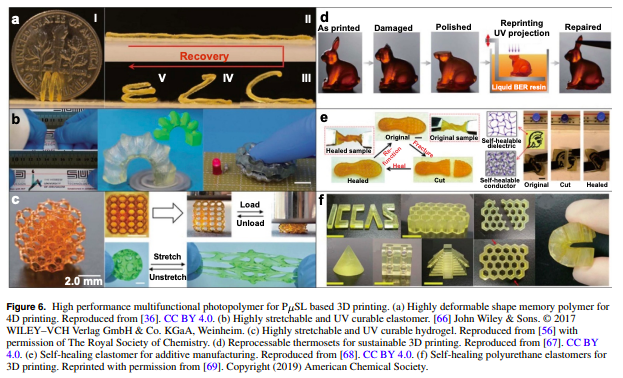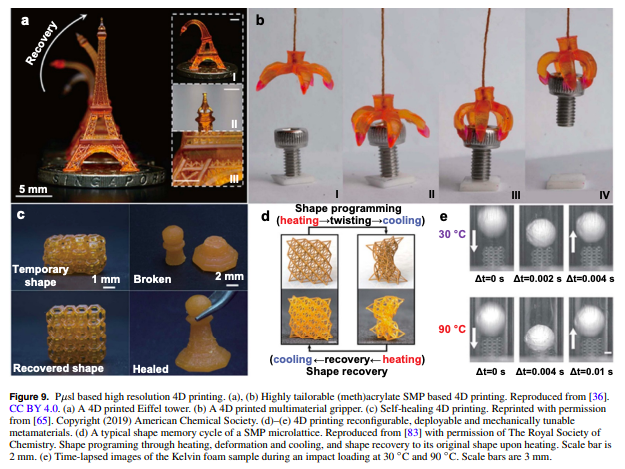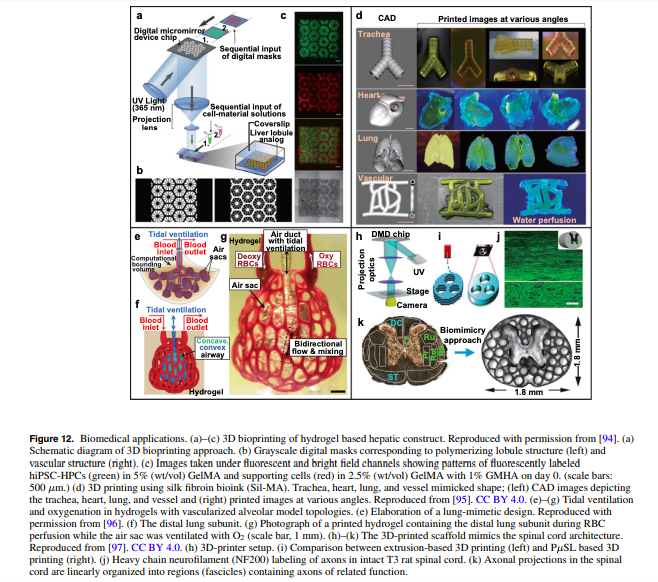Focusing in on more complex, high-resolution digital fabrication, a team of scientists has come together to review projection micro stereolithography (PμSL) 3D printing technologies, releasing the details of their study in “Projection micro stereolithography based 3D printing and its applications.” Because of the growing proliferation of PμSL and other micro- and nanoprinting technologies, we thought it would be helpful to relay the authors’ work here.
Centered around photopolymerization, employing UV light to create structures, PμSL offers a resolution of up to 0.6 μm and allows for multiscale, multimaterial printing. While there are many new techniques continually emerging based on expansive categories like fused deposition modeling, direct ink writing, inkjet, stereolithography (SLA), and more, PμSL is unique as a method for printing at the microscale.
Developed in 2005, the initial version of PμSL took traditional digital light process, which casts UV light onto a bed of resin, and shrunk it down. The original system produced highly complex structures like a micro-spring array and a thread with details as small as 0.6 μm. Performance was refined further by Zheng et al. with the use of liquid crystal on silicon chip to create the layer masks and a UV LED for the curing source. This allowed for more complex overhangs and structures like an octet truss unit cell, and materials with greater porosity.
Commercialization of PμSL-based 3D printing began a couple of years ago, via BMF Materials Technology Co., known for its expertise in micro/nanofabrication. The improved system offers two different large-area printing options:
- 2 μm per pixel with 50 mm ×50 mm printing area (nanoArch S130)
- 10 μm per pixel with 94 mm ×52 mm printing area (nanoArch S140).
“The total fabrication area can be further divided into multiple subareas which are smaller than a single projection. When a layer of subarea is printed, the X and Y stages move horizontally for the fabrication of a neighboring subarea,” stated the authors.
The nanoArch has been used in biomedical applications, as well as the creation of micro-mechanical devices and structural parts for engineering projects.
Other improvements have been made to PμSL 3D printing to achieve a multimaterial, multiscale, multifunctional technology. To achieve large-scale PμSL, the technique was combined with an optical scanning system, as well as using “immersed surface accumulation” 3D printing where a light guide tool offers continuous light beam projection, casting UV patterns on a 3.67 mm × 2.75 mm with a resolution of 2.5 μm per pixel.
“Among all the 3D printing technologies, the multimaterial fabrication can be easily realized in FDM and DIW through simply adding extra printing nozzles to deposit different materials, and inkjet 3D printing technology in which photocurable resin is jetted over a surface through micro-nozzles followed by curing with UV light,” explain the researchers. “However, compared with the above discussed 3D printing technologies, the development of multimaterial PµSL based 3D printing systems remain comparatively limited due to the difficulties of exchanging polymer resins.”
The authors point out that, while multimaterial 3D printing is more easily achievable with fused deposition modeling and direct ink writing, PµSL has been limited by the difficulties inherent in swapping out polymer resins. Researchers have attempted to rectify these issues with more complex multi-material systems, as shown below, that include modifying the fibers within a resin using magnetic fields.
The authors then go on to describe multifunctional capabilities that have been developed for PµSL. Numerous (meth)acrylate-based UV curable polymers have been experimented with for use in applications that include 4D printing with shape memory polymers—able to morph for various uses, according to the changing environment.
Further, 4D printing was explored in the production of tools like a micro-gripper feature soft material on the tips, and also the development of a UV curable double-network system for self-healing 4D printing. Other unique applications include the 3D printing of structures made from artificial Abalone shell, Peacock mantis shrimp, and Mammalian cortical bone in which magnetic nanoparticles were aligned via magnetic field to create unique properties in terms of stiffness, strength and toughness. One team used PµSL to 3D print a model made up of hiPSC-HPCs with human umbilical vein endothelial cells and adipose derived stem cells, which demonstrated a number of liver cell characteristics that were improved over traditional bioengineering techniques.
The authors did note room for advancement, particularly with regard to ceramic parts:
“There have been attempts to use DLP or SLA to 3D print ceramic parts by either using ceramic particles loaded precursor or polymer derive ceramics. However, the printing high resolution and high density ceramic parts by using PμSL has not yet been achieved due to lack of fundamental studies on the effect of highly viscous ceramic particles loaded precursor on the printing process and resolution as well as limited ceramics can be printing using polymer derive ceramics,” said the researchers.
“In conclusion, once the capabilities of big image data processing, voxel printing as well as ceramics printing are established, PμSL will become a more powerful 3D printing technology which will be more widely adopted by industry.”
3D printing continues to be refined for expansive applications in automotive, aerospace, and medical and dental—but also figures in predominantly to other work with metamaterials, as well as advancing to the next level in 4D.
[Source / Images: ‘Projection micro stereolithography based 3D printing and its applications’Subscribe to Our Email Newsletter
Stay up-to-date on all the latest news from the 3D printing industry and receive information and offers from third party vendors.
You May Also Like
Why Corrosive Resistant Materials Are Important to the Success of 3D Printing Across Industries
The adoption of additive manufacturing (AM) is accelerating across many major industries. As this technological shift unfolds, the importance of corrosion resistance has emerged as a challenge for 3D printing...
America Makes Announces IMPACT 2.0: $6.6M in New 3D Printing Funding
America Makes, the Manufacturing Innovation Institute (MII) based in Youngstown, Ohio, has announced IMPACT (Improvement in Manufacturing Productivity via Additive Capabilities and Techno-Economic Analysis) 2.0, a project call which will...
3D Printing Webinar and Event Roundup: April 14, 2024
We’re starting off the week’s 3D printing webinars and events at ASTM AMCOE’s 11th Snapshot Workshop and MACH Exhibition. Stratasys continues its advanced training courses, SME is holding a virtual...
AMUK Welcomes Airframe Designs as British 3D Printing Industry Grows
While the UK is not the hub for 3D printer and materials manufacturers as other nations, the country continues to excel at the research, development, and application of additive manufacturing...






































